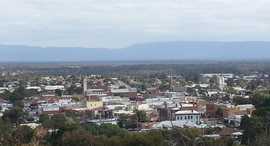Stawell, Victoria
|
Stawell Victoria |
|||||||
|---|---|---|---|---|---|---|---|

View south over Stawell toward the Grampians National Park from Big Hill lookout
|
|||||||

Main street, Stawell
|
|||||||
| Coordinates | 37°03′0″S 142°46′0″E / 37.05000°S 142.76667°ECoordinates: 37°03′0″S 142°46′0″E / 37.05000°S 142.76667°E | ||||||
| Population | 6,150 (2011 census) | ||||||
| Established | 1853 | ||||||
| Postcode(s) | 3380 | ||||||
| Elevation | 231 m (758 ft) | ||||||
| Location | |||||||
| LGA(s) | Shire of Northern Grampians | ||||||
| County | Borung | ||||||
| State electorate(s) | Ripon | ||||||
| Federal Division(s) | Mallee | ||||||
|
|||||||
Stawell (pronounced /stɔːl/, "Stawl"), is an Australian town in the Wimmera region of Victoria 237 kilometres (147 mi) west-north-west of the state capital, Melbourne. Located within the Shire of Northern Grampians local government area it is a seat of local government for the shire and its main administrative centre. At the 2011 census, Stawell had a population of 6,150.
It was founded in 1853 during the Victorian gold rush and is one of few towns in Victoria retaining an active gold mining industry.
Stawell is famed for the Stawell Gift, a professional foot race. It is also known as the gateway to the Grampians National Park.
It is named after Sir William Foster Stawell (1815–89), the Chief Justice of Victoria.
William McLachlan discovered alluvial gold at Pleasant Creek in May 1853, but the yield was not in sufficient volumes to attract much interest, as the Ballarat and Bendigo fields were known to be giving better results, and had already established the infrastructure to support the miners. There was however sufficient numbers for the area to support the beginnings of a settlement. The town site was first settled during 1853 and was named Pleasant Creek. The mining population of the Stawell field remained relatively small (averaging 200 or less) until 1857 when a series of new alluvial gold discoveries were made.
In August 1857 more extensive prospecting and mining occurred at what became known as Commercial Street, Pleasant Creek.
Two Post Offices were opened, Pleasant Creek on 19 October 1857 and Quartz Reef, Pleasant Creek on 1 June 1859. In 1858 diggers opened the Great Western goldfield, which was worked by some 9,000 prospecters. The prospecting spread to nearby Deep Lead, about 6 kilometres to northwest, and it was reported that at the height of the rush there were over 25,000 people in the area. At the same time, shafts were being sunk around Big Hill, becoming known as the Quartz Reefs. Much alluvial gold was found in the area but the 'fossicking' petered out by 1859.
...
Wikipedia

